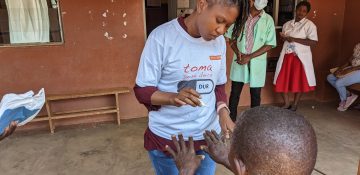Final project evaluation
Results in Health conducted a final evaluation of the project in the last months of 2024. Find the reports below on this page.

Evaluation main takeaway messages
- 1) The Ready4PEP project, introducing SDR-PEP in Mozambique and Nigeria, has significantly contributed to the revitalisation of the leprosy control programs in the two countries.
- 2) SDR-PEP administration has been integrated into the national policies and guidelines for the diagnosis and treatment of leprosy patients in Nigeria and it is on its way to being approved also in Mozambique.
- 3) SDR-PEP administration was integrated with active case finding and community mobilization activities and outreach strategies, like door-to-door screening and mini-campaigns, demonstrated to be effective approaches, especially in remote rural areas.
- 4) The project results indicate that SDR-PEP has a high level of acceptability and feasibility, with very low refusal rates and a high level of coverage of contacts at risk.
- 5) Improving knowledge and skills of health care providers, especially in peripheral areas, has been key to increasing the number of diagnosed patients.
- 6) SDR-PEP has contributed to reducing the stigma around leprosy, making it not just a treatable, but also a preventable disease.
- 7) Combined Self-care groups played an important role in ensuring adequate care and inclusion of persons affected, as well as in reducing stigma at the community level. They have facilitated the introduction of leprosy prevention efforts and have been developed in close collaboration with healthcare providers and managers. However, their full inclusion in the national health
systems and programs is still in development. - 8) Community activists, volounteers and leaders play a vital role in case finding, community mobilisation, SDR-PEP acceptance and stigma reduction.
- 9) Integration with other health programs such as NTDs, TB and rehabilitation initiatives has been explored in the project and has shown potential for ensuring sustainability.
- 10) Technological innovations such as SkinApp and GIS mapping of leprosy cases contributed to the effectiveness of the activities.
- 11) Availability of rifampicin and MDTs have been the major challenges for the project implementation and will need further attention in the future. Global mechanisms can contribute to facilitating the availability of rifampicin and MDTs.